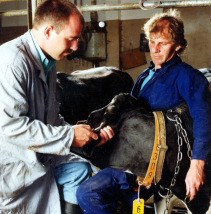Oct 25, 2003By Jonathan Collins
Oct. 27, 2003 – Texas Instruments has been a leading provider of RFID tags and readers for more than a decade. The company, headquartered in Dallas,focused on low-frequency (125 KHz) and high-frequency (13.56 MHz) systems. Even as competitors such as EM Microelectronic and Philips Semiconductors moved to UHF (850-915 MHz), and the Electronic Product Code (EPC) technology (which is primarily focused on UHF) developed by the Auto-ID Center gained ground, TI stuck to its roots.
Then in September, TI dropped a bomb on the RFID market. The company, which markets RFID products through its TI-RFid unit, revealed that it was moving into the UHF market, had joined EPCglobal, the organization charged with commercializing EPC technology, and would produce EPC-compliant RFID tags when the specifications were finalized.
The move was a key vote of confidence for the fledgling organization, a joint venture between EAN International and the Uniform Code Council. An EPC is a unique number, stored on an RFID tag, that identifies a specific item in the supply chain. Combined with related auto-ID technologies, the EPC promises to enable immediate, automatic identification of—and sharing of information on—goods in the supply chain.
Companies that join EPCglobal can participate in standards meetings, and TI-RFid is expected to play a big role in shaping the development of the technology. The company is one of the world's largest manufacturers of RFID transponders and has long been a key figure in the development of RFID. Because of the sheer scale of its design and manufacturing operations, market presence and technical abilities, TI’s endorsement of the EPC should significantly boost the potential of the standard being adopted by other companies in the supply chain. “Our joining the EPC is certainly a bigger step for EPCglobal than it is for TI,” says Anthony Sabetti, global business unit manager for TI-RFid.
One reason that TI-RFid holds such industry clout is that it is one of the few transponder makers that fabricates its own silicon chips. Most transponder makers buy silicon chips from semiconductor companies and then attach those chips to antennas to create finished RFID transponders. And few chip makers, including key rival Philips Semiconductors, produce transponders.
Texas Instruments is also the second largest producer of integrated circuit chips in the world. TI-RFid’s high- and low-frequency RIFD tags combined account for around 22 percent of the RFID chip global market, according to analysts at Venture Development Corp.
TI's support of the EPC standard not only gives EPCglobal a lot of credibility, say analysts, but also will likely spur the supply chain's adoption of the technology. “TI is truly a pioneer and a longtime believer in the RFID industry. Their decision to back EPC is a big seal of approval. They were one of the last major manufacturers to join the group,” says Deepak Shetty, research analyst at Frost & Sullivan.
But with market momentum growing and EPC standards development moving closer to finalization, TI believes it can no longer ignore EPC's potential to drive RFID uptake in the supply chain. “EPC is very exciting,” says Sabetti. “A standard for RFID in SCM has been elusive, and EPC is a major step forward in making it a major market for us.”
Anyone who thinks TI-RFid will cede the market to smaller competitors is mistaken. The company has already signaled its plans to be aggressive by stating that it will have UHF EPC tags on the market within six months of a finalized EPC standard, although that finalized standard is still a year or so away. Analysts maintain that TI-RFid has already shown that it has the resources to be a fierce competitor. “In the last year or so, it has definitely done extremely well developing new 13.56 MHz lines to push into the security space,” says Frost & Sullivan’s Shetty.
The company’s decision to deliver UHF tags comes after years of sitting on the sidelines. Satisfied with the sales of its low- and high-frequency RFID products, the company was not convinced that UHF and EPC were a credible competitive technological or market threat. But analysts maintain that TI’s cautious approach has done little to harm its potential in the market. "They may be new to UHF, but they are still very well positioned with their solid brand recognition as one of the global leaders in RFID,” says Mike Liard, senior AIDC (automatic identification and data capture) and RFID analyst at Venture Development Corp.
TI saw the potential for EPC take off in June when Wal-Mart, the world’s largest retailer, announced that its top 100 suppliers will have to place UHF tags on all their palettes and cases starting in January 2005. That mandate, along with EPC's healthy progressive development as a standard, helped circumvent two key problems that have held back deployment of RFID in SCM. “For years, deployment of RFID in SCM has been very difficult because of a lack of open standards and because of the difficult issue of the person who pays for the tags not reaping all the benefits from that investment,” says Sabetti.
Consumer goods suppliers were not convinced that RFID's return on investment warranted the costs of adopting the new technology. But the sheer size and purchasing power of Wal-Mart have made these issues moot; suppliers must deploy RFID regardless of whether they can reap all the benefits. Because Wal-Mart’s decision will likely create a significant upswing in demand for EPC tags and equipment—the retailer's plan will require 1 billion tags in the first year alone—TI-RFid believes that its existing manufacturing capacity and experience will be critical to satisfy the marketplace.
"Wal-Mart means a significant boost in tag demand. No one is in a position to have that capacity today, but we certainly have the ability to help match that demand," says Sabetti. At present TI-RFid manufactures around 100 million tags a year. The company makes 90 percent of those tags in its own facilities, and it has the capacity to increase production.
"With EPC set to take off like gangbusters, there will be a tremendous need for volume production,” says Venture Development Corp.’s Liard. “TI is clearly set to capture a piece of that pie
As one of the few transponder makers that fabricates its own silicon chips, TI-RFid also believes its silicon-manufacturing capacity will give it advantages over competitors that have to buy chips to create EPC transponders. It will be able to offer tags that are cheaper and have greater functionality.
TI-RFid says it will build on that experience to create tags and applications that can deliver additional features over and above the "license plate" style numbering called for in the EPC standard. "EPC provides a minimal standard so that readers and tags from many vendors can share information," says Sabetti, "but vendors like TI-RFid will deliver enhancements to that standard. Without that ability to add vendor specific enhancements, there would be little vendor interest to produce equipment for the market, as it would be reduced to a simple commodity product."
Although TI-RFid is committed to offering EPC tags, the company says it has yet to determine whether it will develop UHF readers or reader chips. Analysts say that developing readers would enable TI to leverage enhancements to its EPC offerings because the readers would be able to use any additional functionality that the company builds into its tags. At present, TI-RFid develops reader chips and some readers, but 85 percent of its revenue comes from its tag sales. So far just around 10 percent of the unit’s revenues come from reader chips, but that’s growing, according to Sabetti.
TI-RFid also says it sees limits to the EPC technology, and it is far from abandoning its low- and high-frequency markets. "UHF still has problems, especially reading well at very short distances,” says Bill Allen, e-marketing manager for TI-RFid. “We feel that UHF tags have their advantages and disadvantages, so we will continue to market all our products."
Even so, TI-RFid knows that its decision to join EPCglobal will bring a new and powerful voice to the development of the EPC standard. “TI has always been involved in developing RFID standards. Five years ago, and alongside Philips, we championed the ISO 15693 standard for 13.56 MHz smart labels that was the first legitimate RFID standard achieved in collaboration with manufacturers,” says Sabetti.
Analysts expect the company will likely do the same with EPC. “TI is well represented and respected within standards organizations. Its entry into UHF and support of EPC will only bolster standards development efforts,” says Liard.
Because TI has traditionally had a lot of past success in influencing the shaping of ISO standards to its liking, analysts suspect that TI’s influence will help push the EPC standard closer to similar standards—primarily ISO 18000—currently being developed by the ISO.
"There could well be a trickle down from EPC to the ISO, and TI could definitely influence that to some extent given its size,” says Frost & Sullivan’s Shetty. Ultimately, because TI is a global supplier of RFID equipment, the company is eager for the EPC standard to be recognized globally through on-going work at the ISO.
“For the industry and as far as the user is concerned, the fewer standards there are the easier life will be,” says Sabetti. “We do support ISO and EPC standards becoming as close as possible.”
TI-RFid has yet to determine whether it will have to hand over control of any intellectual property to EPCglobal as part of its aid to that development of an EPC standard. What is certain is that the company has no intention of letting the market take off without its involvement. And TI-RFid’s involvement could have far-reaching impact on the emerging standard’s development and on the shear scale and potential for the RFID market in the supply chain space.



